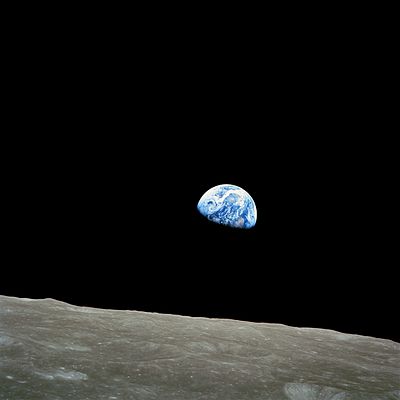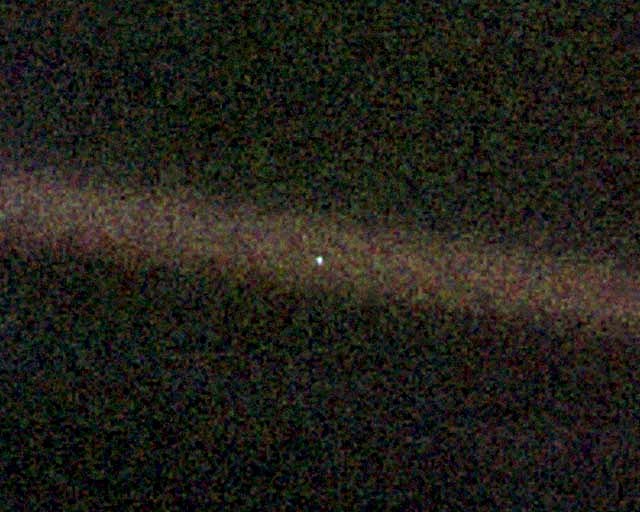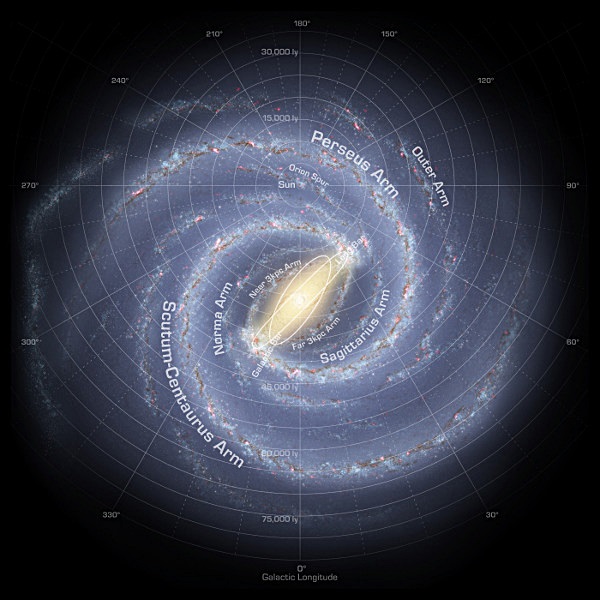Earth ~ A Pale Blue 0.12 Pixel
 Monday, December 30, 2013 at 5:18AM
Monday, December 30, 2013 at 5:18AM  EarthriseYears ago when I was in seminary in Berkeley, California, a professor asked what was the most significant phenomenon to have occurred for humankind (if my memory serves, it was that dramatic and not, for example, the most important event in that particular year or decade). Possibilities were offered and all were wrong. The thing he had in mind was the photo of the earth rising over the horizon of the moon. The photo is now called Earthrise (NASA image AS8-14-2383) and was taken on December 24, 1968 by astronaut William Anders during the Apollo 8 mission, which was the first time human beings orbited the moon.
EarthriseYears ago when I was in seminary in Berkeley, California, a professor asked what was the most significant phenomenon to have occurred for humankind (if my memory serves, it was that dramatic and not, for example, the most important event in that particular year or decade). Possibilities were offered and all were wrong. The thing he had in mind was the photo of the earth rising over the horizon of the moon. The photo is now called Earthrise (NASA image AS8-14-2383) and was taken on December 24, 1968 by astronaut William Anders during the Apollo 8 mission, which was the first time human beings orbited the moon.
 The Pale Blue DotA second space photo is also reputedly a photo that has changed things forever: The Pale Blue Dot. The photo was taken by Voyager 1 on Valentine’s Day in 1990 when the space craft was 3.7 billion miles (6 billion kilometres) from Earth. In the photo Earth is only 0.12 pixel in size. Voyager was launched by NASA on September 5, 1977 to study the outer solar system and now 36 years, 4 months later (as of this writing) it is still sending messages back to Earth (it will do so until 2025). On August 25, 2012 Voyager left our solar system and entered interstellar space, the first human made craft to do so. In approximately 40,000 years Voyager 1 will be within 1.6 light-years (still some distance by human reckoning) form the red dwarf star Gliese 445, which is 17.6 light-years from our sun.
The Pale Blue DotA second space photo is also reputedly a photo that has changed things forever: The Pale Blue Dot. The photo was taken by Voyager 1 on Valentine’s Day in 1990 when the space craft was 3.7 billion miles (6 billion kilometres) from Earth. In the photo Earth is only 0.12 pixel in size. Voyager was launched by NASA on September 5, 1977 to study the outer solar system and now 36 years, 4 months later (as of this writing) it is still sending messages back to Earth (it will do so until 2025). On August 25, 2012 Voyager left our solar system and entered interstellar space, the first human made craft to do so. In approximately 40,000 years Voyager 1 will be within 1.6 light-years (still some distance by human reckoning) form the red dwarf star Gliese 445, which is 17.6 light-years from our sun.
It is argued that Earthrise demonstrates to humankind how beautiful and fragile is its home. The Pale Blue Dot declares that all that we have been, are and will be is being lived out on what Carl Sagan calls a “very small stage in a vast cosmic arena.” It has been argued that the ideas of beauty, fragility and insignificance as illustrated in these two photos have changed us forever. Perhaps they have, but I would like to see some evidence. Don’t get me wrong. I find both photos inspiring. But life changing for our species?
We are still beating our beautiful and fragile environment to death. Yes, we have made progress and, yes, Earthrise probably is the most important environmental photo ever taken. And yet, humankind is the cause of species extinction and may be the cause of a mass extinction event in the future. We continue to burn fossil fuels with abandonment, which might make Earth uninhabitable for most species, including our own, in the not so distant future (if you think I’m being overly dramatic look up what will happen if the methane in frozen tundra and in the oceans is released, and that is just one game changing possibility).
A short list of anthropogenic effects on the environment might be helpful: climate change; conservation; energy (conservation, renewable, environmental impact, etc.); environmental degradation; environmental health (air quality, water quality, soil erosion, effects on human health, etc.); genetic engineering; intensive farming; land degradation (pollution, desertification, etc.); soil (conservation, erosion contamination, etc.); land use (urban sprawl, habitat destruction, etc.); nanotechnology; nuclear issues (fallout, meltdown weapons, waste, etc.); overpopulation; ozone depletion; pollution; resource depletion (consumerism, over fishing, logging, mining, etc.); toxins; waste.
If the Pale Blue Dot, only 0.12 pixel at only 3.7 billion miles away (we’re talking about the universe here don’t forget), is supposed to put in perspective our over blown self-importance and usher in a time of greater humbleness and understanding, then I’m discouraged. We continue to butcher each other over political lines drawn in sand, dirt, water and air (and if our civilisation survives the climate crisis we will no doubt draw lines in low earth orbit and then on the moon). We continue to butcher each other over ideologies that won’t even last long, relatively speaking, on our pale blue dot. We continue to oppress and exploit each other. We continue to beat and murder each other. We even continue to beat and murder our children. The perspective offered by The Pale Blue Dot seems to be meaningless in real terms.
Question: Is there a relationship between the self-image of our own importance and the way we treat each other? Whatever the answer it must be said that our proclaimed exceptionalism is extremely resilient. From the pre-science belief that the earth was the centre of the cosmos to today’s Anthropic Principle, that has been co-opted by religion and philosophy claiming that the universe is “compelled” or “created” to enable little old us to evolve or be created, our belief in our own exceptional status has rarely wavered. In this regard, perhaps some perspective would be helpful.
 Milky Way, Orion Arm and the SunOur sun, and thus our planet, is situated within the inner rim of the Orion Arm of the Milky Way, which happens to be a minor arm of our galaxy. That puts us somewhere between 25,000 to 28,000 light-years from the centre of our galaxy. We, with our sun, have made approximately eighteen galactic orbits, which is a trip of about a 250 million year trip. Our sun is eighteen galactic years old. At fifteen galactic years old the most the planet earth had to offer in the way of life was unicellular microbes and multicellular bacterial colonies. And as Lee Billings says in Five Billion Years of Solitude, when we reach twenty-two galactic years old “some thousand million years hence, our planet may well return to its former barren state.”[1] In about 5.4 billion years when the sun has converted all its hydrogen into helium it will expand into a red giant, engulfing all the inner planets and perhaps earth. And if it does not actually obliterate earth it will burn it to a crisp rendering our pale blue dot an uninhabitable lump of molten rock. No exceptions.
Milky Way, Orion Arm and the SunOur sun, and thus our planet, is situated within the inner rim of the Orion Arm of the Milky Way, which happens to be a minor arm of our galaxy. That puts us somewhere between 25,000 to 28,000 light-years from the centre of our galaxy. We, with our sun, have made approximately eighteen galactic orbits, which is a trip of about a 250 million year trip. Our sun is eighteen galactic years old. At fifteen galactic years old the most the planet earth had to offer in the way of life was unicellular microbes and multicellular bacterial colonies. And as Lee Billings says in Five Billion Years of Solitude, when we reach twenty-two galactic years old “some thousand million years hence, our planet may well return to its former barren state.”[1] In about 5.4 billion years when the sun has converted all its hydrogen into helium it will expand into a red giant, engulfing all the inner planets and perhaps earth. And if it does not actually obliterate earth it will burn it to a crisp rendering our pale blue dot an uninhabitable lump of molten rock. No exceptions.
The Milky Way has around 300 billion stars and astronomers are saying there may be up to 17 billion earth-like planets among them.[2] Along with our Milky Way it’s estimated that there may be up to 500 billion galaxies in the universe containing at least 70 sextillion stars (one sextillion equals 1000 trillion). You can bet a lot of those 70 sextillion stars are earth-like and a number of them are in their star’s Goldilocks zone.
When NASA turned Voyage 1 around to take a “family photo” of our solar system they did so on the request of Carl Sagan. He wrote a book entitled Pale Blue Dot: A Vision of the Human Future in Space. Quoting Sagan seems like a good way to end:
Look again at that dot. That's here. That's home. That's us. On it everyone you love, everyone you know, everyone you ever heard of, every human being who ever was, lived out their lives. The aggregate of our joy and suffering, thousands of confident religions, ideologies, and economic doctrines, every hunter and forager, every hero and coward, every creator and destroyer of civilization, every king and peasant, every young couple in love, every mother and father, hopeful child, inventor and explorer, every teacher of morals, every corrupt politician, every "superstar," every "supreme leader," every saint and sinner in the history of our species lived there-on a mote of dust suspended in a sunbeam.
The Earth is a very small stage in a vast cosmic arena. Think of the endless cruelties visited by the inhabitants of one corner of this pixel on the scarcely distinguishable inhabitants of some other corner, how frequent their misunderstandings, how eager they are to kill one another, how fervent their hatreds. Think of the rivers of blood spilled by all those generals and emperors so that, in glory and triumph, they could become the momentary masters of a fraction of a dot.
Our posturings, our imagined self-importance, the delusion that we have some privileged position in the Universe, are challenged by this point of pale light. Our planet is a lonely speck in the great enveloping cosmic dark. In our obscurity, in all this vastness, there is no hint that help will come from elsewhere to save us from ourselves.
The Earth is the only world known so far to harbor life. There is nowhere else, at least in the near future, to which our species could migrate. Visit, yes. Settle, not yet. Like it or not, for the moment the Earth is where we make our stand.
It has been said that astronomy is a humbling and character-building experience. There is perhaps no better demonstration of the folly of human conceits than this distant image of our tiny world. To me, it underscores our responsibility to deal more kindly with one another, and to preserve and cherish the pale blue dot, the only home we've ever known.
Copyright © 2013 Dale Rominger
[1] Billings, Lee. Five Billion Years of Solitude. New York: Current, 2013, p.31.
[2] While the search for exoplanets is a relatively new field of astronomy new techniques and discoveries are accelerating. The app on my tablet that notifies me every time a new exoplanet is confirmed lists 987 confirmed exoplanets and 996 selected planets for further study. Wikipedia http://en.wikipedia.org/wiki/Exoplanet claims 1056 exoplanets in 802 solar systems have been confirmed. The number will rise exponentially.
Reader Comments